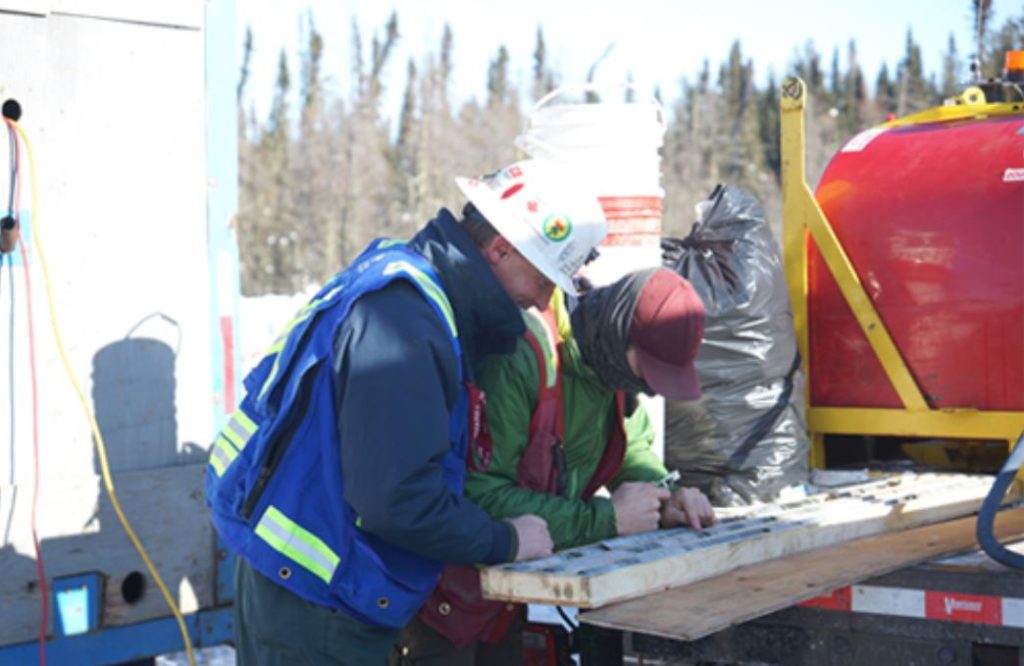CanAlaska Uranium conducting geophysical survey at Geikie, Saskatchewan

CanAlaska Uranium Ltd. [CVV-TSXV; CVVUF-OTCQX; DH7N-FSE] has begun a high-resolution helicopter-borne versatile time-domain electromagnetic plus (VTEM plus) survey on its 60%-owned Geikie project in the Athabasca basin, northern Saskatchewan.
The purpose of the survey is to identify basement conductors, characterize lithological and alteration variations, and refine the structural setting of the Geikie project in order to define drill targets.
The company has also released the results of a geological prospecting program completed on the Geikie project. The prospecting program identified favourable host rocks for basement-hosted uranium mineralization that contain elevated pathfinder elements and uranium anomalism in the GK1 and GK2 target areas.
Initial exploration conducted on the Geikie project, consisting of high-resolution airborne radiometric and magnetic surveying, identified four high-priority target areas associated with major north-south trending structural features.
A prospecting and mapping program was carried out in the fall to ground truth the anomalies identified during the initial airborne survey. Lithological and/or structural data was collected from 73 locations over 9 days along with outcrop and float samples. The prospecting group carried scintillometers or spectrometers, collecting spatial survey data in order to help identify elevated uranium levels throughout the Geikie project. Thirty-nine rock chip samples were also collected from outcrops and float. The majority of the rock chip samples were taken from the GK1 and GK2 prospects, with 16 samples taken at GK1 and 18 samples collected at GK2.
Ground Prospecting Results: The GK1 target area is a large cluster of radiometric anomalies within a 9-km by 3-km area with a north-easterly trend, located in the northern quarter of property. A historic electromagnetic survey exists for the western portion of the identified target which appears to show a strong conductor running parallel to the anomalous cluster. Two significant northerly trending structural corridors intersect this target area.
Prospecting results confirmed uranium-rich granites and pegmatites, with uranium total values up to 297 ppm located adjacent to metasedimentary rocks suitable for hosting mineralization.
Within these metasedimentary units, reconnaissance rock chip samples show elevated pathfinders element concentrations locally (Ni, V, Zn, Co) as well as localised enrichments in REE. A radioactive psammite outcrop (up to 7,200 cps – scintillometer), returned a slightly elevated uranium total value of 34.6 ppm, molybdenum total value of 53.4 ppm, and strongly anomalous lead isotope ratios (207Pb/206Pb=0.14).
Additionally, a strong correlation between metasediment outcrops and magnetic low anomalies from the initial airborne magnetics survey provide a high level of confidence both in the data obtained from the earlier magnetics survey, and the regional interpretations of the project area.
The GK2 target area is one of the few localities on the project with historical prospecting information, with historical grab samples recorded up to 0.225% uranium and 0.18% uranium, within mapped Wollaston calcsilicate
The GK3 target area has a discrete coherent radiometric anomaly, located at an interpreted structural complexity. The basement geology appears to be disrupted by a north-westerly trending structure that is coincident with the anomalous historical uranium grab samples from GK2 to the south. The GK4 target is a strong coherent radiometric anomaly striking north-easterly and has been mapped as Wollaston calcsilicate rocks.
In collaboration with its partner, the company is developing a systematic exploration strategy for the Geikie project.
The next step for exploration is the VTEM Plus survey, now underway. The survey will consist of 1,399 line-km of helicopter-borne surveying at 200 – 400-metre line-spacing across the Geikie project.
An airborne gravity gradiometer (AGG) survey is currently planned, depending on the results of the VTEM Plus survey, for Q1 of 2023. The combination of the magnetics, radiometrics, VTEM Plus survey results, and the planned AGG survey will guide the maiden diamond drilling program for the Geikie project, proposed to commence in 2023.
CanAlaska CEO, Cory Belyk, commented, “Results from the prospecting program highlight the potential of the Geikie project to host uranium mineralization, specifically where significant structural features interact with the correct rocks. The airborne VTEM survey that is currently being completed is a vital dataset to allow for optimization of gravity surveys and definition of priority drill targets. Moving this project forward in a controlled step by step manner will provide very good and prioritized drill targets for the first drilling programs that are planned for 2023.”
The Geikie project is currently under option to Basin Energy Limited [BSN-ASX]. Basin Energy currently owns 40% of the project with the option to increase its interest by 20% (cumulative 60%) by funding AUD$2.5 million in exploration within 24 months of listing. Basin Energy may further increase its interest in the project by 20% (cumulative 80%) by funding an additional AUD$5 million in exploration (cumulative AUD$7.5 million) within 48 months of listing, issuing 2,250,000 shares to CanAlaska and granting CanAlaska a 2.75% NSR royalty, with a repurchase right of 0.50% NSR for AUD$500,000. CanAlaska is the current operator of the Geikie project and will charge an operator fee. CanAlaska owns 19.98% of Basin Energy.
